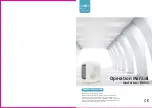
Electrical Installation
Vertiv | Liebert CRD10 | User Manual
58
Table 4-3 Rack Temperature Sensor Address
Sensor
1
2
3
4
5
6
ID
Notations
Rack temperature 1
0
0
0
1
0
0
10
ON
—
“1”;
OFF
—
“0”
Rack temperature 2
0
0
0
1
0
1
11
Rack temperature 3
0
0
0
1
1
0
12
Rack temperature 4
0
0
0
1
1
1
13
Rack temperature 5
0
0
1
0
0
0
20
Rack temperature 6
0
0
1
0
0
1
21
Rack temperature 7
0
0
1
0
1
0
22
Rack temperature 8
0
0
1
0
1
1
23
Rack temperature 9
0
0
1
1
0
0
30
Rack temperature 10
0
0
1
1
0
1
31
4.3.6
Remote Shutdown
As shown in Figure 4-4, terminals 37# and 38# can be connected to the remote shutdown switch. The terminals
must be shorted before delivery. If a remote shutdown signal is to be connected, remove the short-connect
cable.
NOTE: Opening the terminals 37# and 38# will shut down the unit.
4.3.7
External Common Alarm
Terminals 75# and 76# can be connected to the external common alarms. They provide signals to external
alarm devices such as an alarm indicator. When the critical alarm occurs, the contact will be closed to trigger
remote alarms, send signals to the building management system, or automatically dial the paging system. Users
have to obtain the power supply of external common alarm system. For an in-depth definition of the other
terminals, refer to the circuit schematic.
4.3.8
Teamwork Control
•
Teamwork function
Teamwork control has 4 functions, Standby function, Rotation function, Avoid fighting function and Cascade
function.
1.
Standby function
One or several units can be defined as standby unit. Th
e standby units’ fan
run at a default speed of 20%. If
a running unit generates an alarm that cannot operate normally, a standby unit will start to run. The
“c
ritica
l fault alarms” will cause the unit
t
o go into standby. The “secondary fault alarms” unit w
ill not
standby but continue running.
















































